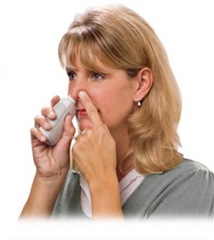As I sit in my hotel room on Maui, watching the sun come up on this island paradise, I think about how fortunate I am to have the type of job that allows me to leave the rain (and occasional snow) of Seattle. I get to wear shorts, read by the pool, and sit on my deck with a morning coffee. I can look out my balcony at some lovely grounds (I don’t have an ocean view), and hear the waves in the distance. Later this morning I might go for a walk and then have my favorite macadamia french toast for breakfast. Life seems pretty darn good!
But what I rarely talk about are the side effects to flying. From frequent time zone changes, inconsistent sleep patterns, injuries from pushing carts and lifting bags, poor eating habits, and exposure to countless germs and illnesses, and allergy, sinus, and ear related problems. It’s that latter problem that is interfering with my enjoyment of my layover on Maui.
Back in 1999 I was diagnosed with adult onset allergies, directly related, my doctor said, to flying. I have no idea how long it had been going on, but what led me to finally seek medical intervention was my inability to clear my ears. All the tricks of the trade, from chewing gum to Valsalva, failed to get my ears to “pop” and clear, so I knew it was time for help. I had fluid in the ear, swelling, sinus issues, the list went on and on, and it was so bad that I was unable to fly for the nearly four month that it took to get things cleared up. (For a easily understandable medical description of why this happens, read this previous guest post.)
Ever since then I’ve been more cognizant of what’s going on, and make sure that I don’t fly when I get the tingling itchiness in my ears that’s the signal of a potential problem. It means that I miss some time from flying, but it keeps me healthier, and more importantly keeps me from getting to a destination but being so blocked that I can’t get on a flight to go home. While I hate missing a flight to Hawaii, when I’m symptomatic, calling in sick is the more responsible choice to make all the way around.
Which is all background to my layover today.
When I arrived yesterday, I felt a little itchiness in my ears. I felt sinus pain on the left side, and had a horrible headache This morning the headache is a little better, but the congestion is still there, and as I rub my ears I feel and hear a little crackling and sloshy sound. This does not bode well.
I’m not going to panic, though, because even though I know that it may not be the most comfortable trip back to the mainland, I do have an ace in the hole that will be there to help me out. For several months now, I’ve been relying on the EarPopper to get me through flights and situations when my ear problems make it difficult to clear. When my ears are totally blocked, I still stay firmly on the ground, but for those days where it could go either way, the EarPopper has greatly improve my quality of life.
I learned about the device rather serendipitously – via Twitter. A tweet by @JetWithAnya caught my eye, led to several email discussions about my ear problems, flying, and her experience and background as a nurse. I explained my history, complained about a hearing loss (most people in this industry will have one), and she recommended setting up a medical appointment to see if I might be a candidate for the EarPopper (it’s available only by prescription).
I’ve tried drugs and nasal spray, with their side effects and limited success, so I was guardedly optimistic when I went to my appointment with a local Nurse Practitioner. The NP had experience in aero-medicine, so she totally understood the nature of flight attendant work, the continually changing of altitudes, and the lifestyle. How wonderful it was not to have to explain my “office” to her. She did the expected examination, looking into my ears, nose, and throat, and pretty quickly summed up the situation – allergy ears. We spent some time talking about preventative things that I could do, including a few new techniques for me to try, and she said that I was a classic candidate for using the EarPopper.
 The NP had a demo model in the office, and she explained to me what it does, how it does it, then showed me how to use it and had me try it out. I thought that I was feeling pretty good, but that first time using it made me realize that my ears were blocked even though I didn’t realize it. My right ear crackled and popped a little bit, but I knew it wasn’t completely clear. My left ear didn’t clear at all.
The NP had a demo model in the office, and she explained to me what it does, how it does it, then showed me how to use it and had me try it out. I thought that I was feeling pretty good, but that first time using it made me realize that my ears were blocked even though I didn’t realize it. My right ear crackled and popped a little bit, but I knew it wasn’t completely clear. My left ear didn’t clear at all.
I filled the prescription for the EarPopper, received it in the mail within a few days, and was excited to start using it. Within a week or so my right ear was completely clear. No backed up sinus pain, no itchy ear, and a remarkable improvement in quality of hearing in that ear. It still remains that way, with good preventative care and using the EarPopper. My right ear has been a tougher go. It still has not completely cleared. I get a little crackling sound like it’s going to clear, but it just doesn’t quite get there. I will be following up with my NP about it, looking to see if there’s some other issue going on, but despite my recalcitrant left ear, the overall awareness and improvement has been a big success.
If you don’t suffer from ear problems, this post won’t have much meaning for you. But if you’re nodding your head as you read this and identifying with the symptoms that I’m talking about, you may benefit from a consultation to determine if you are a candidate for the EarPopper. You may have accepted that ear discomfort and blockage is a fact of life, and that you need to find a way to manage your problems rather than resolve them. You don’t have to.
The EarPopper is not a miracle cure — I’ve been at it for a few months with partial success — and there are still going to be times I will need to stay on the ground. Everyone’s situation is different and you need to consult and work with your health care practitioner about what’s right for you, but you have nothing to lose by starting the dialogue and learning more. The device costs about $200, and may be covered by your insurance plan.
I’d recommend that you check out the EarPopper website and follow @EarPopperNurse on Twitter to learn more and then get a referral to see if this is the right choice for you.
NOTE: I requested a referral to a local health care practitioner and that appointment was covered by my health insurance. The prescription was submitted to EarPopper who graciously provided me with a complimentary device for purposes of seeing how it would work with flight crews. The opinions expressed here are my own, and I can tell you that I consider it worth every penny of its $200 price tag.
Photo credit:


